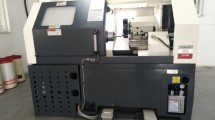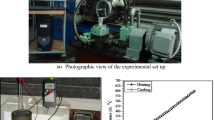Abstract
This paper presents the analysis of average surface roughness, cutting force, and feed force in turning of difficult-to-machine Ti-6Al-4V alloy by experimental investigation and performance modeling. Based on knowledge of the literature, to pacify the elevated temperature in machining Ti-6Al-4V and to ensure a clean environment, the experiments are carried out in cryogenic (liquid nitrogen) condition by following the Taguchi L18 mixed-level orthogonal array. Afterward, the models of responses have been formulated by the response surface methodology (RSM) and artificial neural network (ANN). The higher values of correlation coefficient (≥96%) and lower values of error determined the adequacy of the developed models. Comparative study of both models revealed that the RSM-based model revealed greater accuracy for the testing data and hence recommended. Analysis of variance (ANOVA) determined the effects of cutting speed, feed rate, and insert configuration on the quality characteristics. The results revealed that a cutting speed not exceeding 110 m/min is likely to generate favorable machining responses. In addition, the higher feed rate was found to ensure better machining performances. Moreover, the desirability-based multi-response optimization determined that a cutting speed of 78 m/min, a feed rate of 0.16 mm/rev, and use of the SNMM tool insert are capable of minimizing surface roughness at 1.05 μm, main cutting force at 315 N, and feed force at 208 N.
Similar content being viewed by others
References
Su Y, He N, Li L, Li X (2006) An experimental investigation of effects of cooling/lubrication conditions on tool wear in high-speed end milling of Ti-6Al-4V. Wear 261(7):760–766
Hong H, Riga A, Gahoon J, Scott C (1993) Machinability of steels and titanium alloys under lubrication. Wear 162:34–39
Rahman M, Wong YS, Zareena AR (2003) Machinability of titanium alloys. JSME International Journal Series C 46(1):107–115
Paul S, Dhar N, Chattopadhyay A (2001) Beneficial effects of cryogenic cooling over dry and wet machining on tool wear and surface finish in turning AISI 1060 steel. J Mater Process Technol 116(1):44–48
Mia M, Dhar NR (2016) Optimization of surface roughness and cutting temperature in high-pressure coolant-assisted hard turning using Taguchi method. The International Journal of Advanced Manufacturing Technology:1–15. doi:10.1007/s00170-016-8810-2
Bashir MA, Mia M, Dhar NR (2016) Investigations on surface milling of hardened AISI 4140 steel with pulse jet MQL applicator. Journal of The Institution of Engineers (India): Series C:1–14. doi:10.1007/s40032-016-0277-2
Islam AK, Mia M, Dhar NR (2016) Effects of internal cooling by cryogenic on the machinability of hardened steel. The International Journal of Advanced Manufacturing Technology:1–10. doi:10.1007/s00170-016-9373-y
Ghosh S, Rao PV (2015) Application of sustainable techniques in metal cutting for enhanced machinability: a review. J Clean Prod 100:17–34
Machai C, Biermann D (2011) Machining of β-titanium-alloy Ti–10V–2Fe–3Al under cryogenic conditions: cooling with carbon dioxide snow. J Mater Process Technol 211(6):1175–1183
Sun S, Brandt M, Palanisamy S, Dargusch MS (2015) Effect of cryogenic compressed air on the evolution of cutting force and tool wear during machining of Ti–6Al–4V alloy. J Mater Process Technol 221:243–254
Vazquez E, Gomar J, Ciurana J, Rodríguez CA (2015) Analyzing effects of cooling and lubrication conditions in micromilling of Ti6Al4V. J Clean Prod 87:906–913
Moura RR, da Silva MB, Machado ÁR, Sales WF (2015) The effect of application of cutting fluid with solid lubricant in suspension during cutting of Ti-6Al-4V alloy. Wear 332:762–771
da Silva RB, Machado ÁR, Ezugwu EO, Bonney J, Sales WF (2013) Tool life and wear mechanisms in high speed machining of Ti–6Al–4V alloy with PCD tools under various coolant pressures. J Mater Process Technol 213(8):1459–1464
Xie J, Luo M, Wu K, Yang L, Li D (2013) Experimental study on cutting temperature and cutting force in dry turning of titanium alloy using a non-coated micro-grooved tool. Int J Mach Tools Manuf 73:25–36
Zain AM, Haron H, Sharif S (2010) Prediction of surface roughness in the end milling machining using artificial neural network. Expert Syst Appl 37(2):1755–1768
Hasçalık A, Çaydaş U (2008) Optimization of turning parameters for surface roughness and tool life based on the Taguchi method. Int J Adv Manuf Technol 38(9–10):896–903
Hashmi KH, Zakria G, Raza MB, Khalil S (2015) Optimization of process parameters for high speed machining of Ti-6Al-4V using response surface methodology. The International Journal of Advanced Manufacturing Technology:1–10
Moufki A, Dudzinski D, Le Coz G (2015) Prediction of cutting forces from an analytical model of oblique cutting, application to peripheral milling of Ti-6Al-4V alloy. Int J Adv Manuf Technol 81(1–4):615–626
Ramesh S, Karunamoorthy L, Palanikumar K (2012) Measurement and analysis of surface roughness in turning of aerospace titanium alloy (gr5). Measurement 45(5):1266–1276
Mia M, Khan MA, Dhar NR (2016) Performance prediction of high-pressure coolant assisted turning of Ti-6Al-4V. The International Journal of Advanced Manufacturing Technology:1–13. doi:10.1007/s00170-016-9468-5
Mia M, Khan MA, Rahman SS, Dhar NR (2016) Mono-objective and multi-objective optimization of performance parameters in high pressure coolant assisted turning of Ti-6Al-4V. The International Journal of Advanced Manufacturing Technology:1–10. doi:10.1007/s00170-016-9372-z
Dhar N, Kamruzzaman M (2007) Cutting temperature, tool wear, surface roughness and dimensional deviation in turning AISI-4037 steel under cryogenic condition. Int J Mach Tools Manuf 47(5):754–759
Khan MA, Mia M, Dhar NR (2016) High-pressure coolant on flank and rake surfaces of tool in turning of Ti-6Al-4V: investigations on forces, temperature, and chips. The International Journal of Advanced Manufacturing Technology:1–15. doi:10.1007/s00170-016-9511-6
Mia M, Khan MA, Dhar NR (2016) High-pressure coolant on flank and rake surfaces of tool in turning of Ti-6Al-4V: investigations on surface roughness and tool wear. The International Journal of Advanced Manufacturing Technology:1–10. doi:10.1007/s00170-016-9512-5
Hanafi I, Khamlichi A, Cabrera FM, Nuñez López PJ (2012) Prediction of surface roughness in turning of PEEK cf30 by using an artificial neural network. Journal of the Chinese Institute of Industrial Engineers 29(5):337–347
MacKay DJ (1992) Bayesian interpolation. Neural Comput 4(3):415–447
Foresee FD, Hagan MT Gauss-Newton approximation to Bayesian learning. In: International conference on neural networks, 1997. 1997. IEEE, pp 1930–1935
Ezugwu E, Fadare D, Bonney J, Da Silva R, Sales W (2005) Modelling the correlation between cutting and process parameters in high-speed machining of Inconel 718 alloy using an artificial neural network. Int J Mach Tools Manuf 45(12):1375–1385
Draper NR, Smith H, Pownell E (1966) Applied regression analysis, vol 3. Wiley, New York
Mia M, Bashir MA, Khan MA, Dhar NR (2016) Optimization of MQL flow rate for minimum cutting force and surface roughness in end milling of hardened steel (HRC 40). The International Journal of Advanced Manufacturing Technology:1–16. doi:10.1007/s00170-016-9080-8
Mia M, Razi MH, Ahmad I, Mostafa R, Rahman SMS, Ahmed DH, Dey PR, Dhar NR (2017) Effect of time-controlled MQL pulsing on surface roughness in hard turning by statistical analysis and artificial neural network. The International Journal of Advanced Manufacturing Technology:1–13. doi:10.1007/s00170-016-9978-1
Mia M, Dhar NR (2016) Response surface and neural network based predictive models of cutting temperature in hard turning. J Adv Res 7(6):1035–1044
Mia M, Dhar NR (2016) Prediction of surface roughness in hard turning under high pressure coolant using artificial neural network. Measurement 92:464–474
Mia M, Al Bashir M, Dhar NR Effects of cutting parameters and machining environments on surface roughness in hard turning using design of experiment. In: AIP conference proceedings, 1754
Ayed Y, Germain G, Ammar A, Furet B (2015) Tool wear analysis and improvement of cutting conditions using the high-pressure water-jet assistance when machining the Ti17 titanium alloy. Precis Eng 42:294–301
Dinesh S, Senthilkumar V, Asokan P, Arulkirubakaran D (2015) Effect of cryogenic cooling on machinability and surface quality of bio-degradable ZK60 Mg alloy. Mater Des 87:1030–1036
Lippmann R (1987) An introduction to computing with neural nets. IEEE ASSP Mag 4(2):4–22
Bouacha K, Yallese MA, Mabrouki T, Rigal J-F (2010) Statistical analysis of surface roughness and cutting forces using response surface methodology in hard turning of AISI 52100 bearing steel with CBN tool. Int J Refract Met Hard Mater 28(3):349–361
Sahoo AK, Rout AK, Das DK (2015) Response surface and artificial neural network prediction model and optimization for surface roughness in machining. Int J Ind Eng Comput 6(2):229
Azam M, Jahanzaib M, Wasim A, Hussain S (2015) Surface roughness modeling using RSM for HSLA steel by coated carbide tools. Int J Adv Manuf Technol 78(5–8):1031–1041
Basheer AC, Dabade UA, Joshi SS, Bhanuprasad V, Gadre V (2008) Modeling of surface roughness in precision machining of metal matrix composites using ANN. J Mater Process Technol 197(1):439–444
Aggarwal A, Singh H, Kumar P, Singh M (2008) Optimization of multiple quality characteristics for CNC turning under cryogenic cutting environment using desirability function. J Mater Process Technol 205(1):42–50
Author information
Authors and Affiliations
Corresponding author
Rights and permissions
About this article
Cite this article
Mia, M., Khan, M.A. & Dhar, N.R. Study of surface roughness and cutting forces using ANN, RSM, and ANOVA in turning of Ti-6Al-4V under cryogenic jets applied at flank and rake faces of coated WC tool. Int J Adv Manuf Technol 93, 975–991 (2017). https://doi.org/10.1007/s00170-017-0566-9
Received:
Accepted:
Published:
Issue Date:
DOI: https://doi.org/10.1007/s00170-017-0566-9




